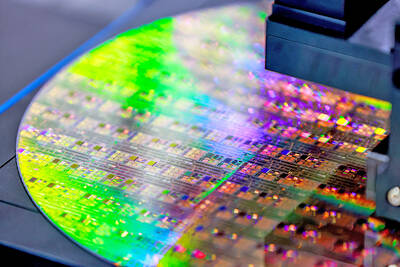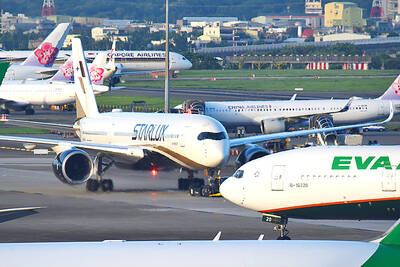The number of mobile phone subscriptions registered for mobile Internet services in Taiwan soared 30 percent year-on-year in the fourth quarter of last year to 11.86 million, but actual usage of the Internet function lagged behind, an industry report said.
The increase of 2.71 million mobile Internet subscriptions meant that 48.8 percent of all cellphone subscriptions had access to Internet service functions, said a report released recently by the Foreseeing Innovative New Digiservices (FIND), a Web site run by the Institute for Information Industry to provide professional information on Internet demographics and trends.
GROWTH
In its report, FIND said that the growth was mainly attributable to a sharp rise in 3G data service subscriptions, which nearly doubled from 3.29 million in the fourth quarter of 2006 to 6.53 million in the fourth quarter of last year.
This accounted for 51.1 percent of all mobile Internet subscriptions.
That share outpaced the 32 percent subscribed for the Internet through general packet radio services (GPRS), a clear indication that 3G is replacing GPRS as the mainstream technology for mobile Internet access.
NO INCREASE
The rise in mobile Internet subscriptions, however, has not necessarily led to an increase in mobile Internet users.
A survey conducted by FIND last August and released in January showed that only 9.7 percent of Taiwan’s population, or 2.22 million people, had gone online using mobile devices.
This was only 1.6 percentage points higher than the number of users registered in 2006.
The results showed that mobile Internet use may not be as popular as it appears to be, FIND analysts said.
Promoting its use remained a major issue to be addressed by mobile network operators, the researcher said.

Taiwan’s rapidly aging population is fueling a sharp increase in homes occupied solely by elderly people, a trend that is reshaping the nation’s housing market and social fabric, real-estate brokers said yesterday. About 850,000 residences were occupied by elderly people in the first quarter, including 655,000 that housed only one resident, the Ministry of the Interior said. The figures have nearly doubled from a decade earlier, Great Home Realty Co (大家房屋) said, as people aged 65 and older now make up 20.8 percent of the population. “The so-called silver tsunami represents more than just a demographic shift — it could fundamentally redefine the

The US government on Wednesday sanctioned more than two dozen companies in China, Turkey and the United Arab Emirates, including offshoots of a US chip firm, accusing the businesses of providing illicit support to Iran’s military or proxies. The US Department of Commerce included two subsidiaries of US-based chip distributor Arrow Electronics Inc (艾睿電子) on its so-called entity list published on the federal register for facilitating purchases by Iran’s proxies of US tech. Arrow spokesman John Hourigan said that the subsidiaries have been operating in full compliance with US export control regulations and his company is discussing with the US Bureau of

Businesses across the global semiconductor supply chain are bracing themselves for disruptions from an escalating trade war, after China imposed curbs on rare earth mineral exports and the US responded with additional tariffs and restrictions on software sales to the Asian nation. China’s restrictions, the most targeted move yet to limit supplies of rare earth materials, represent the first major attempt by Beijing to exercise long-arm jurisdiction over foreign companies to target the semiconductor industry, threatening to stall the chips powering the artificial intelligence (AI) boom. They prompted US President Donald Trump on Friday to announce that he would impose an additional

China Airlines Ltd (CAL, 中華航空) said it expects peak season effects in the fourth quarter to continue to boost demand for passenger flights and cargo services, after reporting its second-highest-ever September sales on Monday. The carrier said it posted NT$15.88 billion (US$517 million) in consolidated sales last month, trailing only September last year’s NT$16.01 billion. Last month, CAL generated NT$8.77 billion from its passenger flights and NT$5.37 billion from cargo services, it said. In the first nine months of this year, the carrier posted NT$154.93 billion in cumulative sales, up 2.62 percent from a year earlier, marking the second-highest level for the January-September